
ISBN: 0897664140 0897664132 9780897664141 Year: 1987 Volume: 509 Publisher: New York, N.Y. New York Academy of Sciences
Abstract | Keywords | Export | Availability | Bookmark
 Loading...
Loading...Choose an application
- Reference Manager
- EndNote
- RefWorks (Direct export to RefWorks)
Pathological haematology --- Blood platelets --- Megakaryocytes --- Von Willebrand factor --- Barnhart, Marion I --- Blood Platelets --- Factor VIII --- Von Willebrand Factor --- physiology --- physiopathology --- Blood platelets - Congresses --- Megakaryocytes - Congresses --- Von Willebrand factor - Congresses --- Factor 8/von Willebrand factor --- Blood platelet physiology --- Platelet-vessel wall interaction --- Megakaryocytopoiesis --- Barnhart, Marion I - Congresses
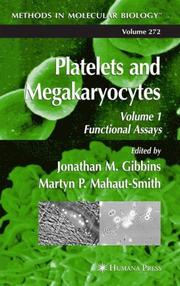
ISBN: 1588291014 1588290115 9786610360192 1280360194 1592597823 9786610360185 1280360186 1592597831 9781588291011 9781588290113 Year: 2004 Volume: 272-273 Publisher: Totowa, NJ : Humana Press : Imprint: Humana,
Abstract | Keywords | Export | Availability | Bookmark
 Loading...
Loading...Choose an application
- Reference Manager
- EndNote
- RefWorks (Direct export to RefWorks)
Platelets are an essential element of the body's hemostasis system, and yet, through their involvement in thrombosis, are also a major cause of morbidity and mortality. Platelets have a limited lifespan and must be continually manufactured by their precursor, the megakaryocyte. In Platelets and Megakaryocytes, Volume 2: Perspectives and Techniques leading expert researchers-many responsible for seminal discoveries in the field-offer basic and advanced techniques for studying cell signaling in the regulation and function of platelets and megakaryocytes, as well as state-of-the-art commentaries on our understanding of these cells. The methods include ligand-binding assays, the study of protein and lipid kinases and phosphatases, the analysis of lipid rafts in the regulation of cell signaling, and the measurement of intracellular calcium levels. There are also techniques for the study of electrophysiological events, nitric oxide signaling, venom proteins, and for the internalization of proteins into platelets through permeabilization. The application of many molecular and post-genomic methods to the study of platelets and megakaryocytes is also described. All protocols follow the successful Methods in Molecular Biology™ series format, each one offering step-by-step laboratory instructions, an introduction outlining the principle behind the technique, lists of equipment and reagents, and tips on troubleshooting and avoiding known pitfalls. A companion volume, Platelets and Megakaryocytes, Volume 1: Functional Assays describes in step-by-step detail basic and advanced techniques for analyzing platelet and megakaryocyte function. Comprehensive and cutting-edge, the two volumes of Platelets and Megakaryocytes offer novice and experienced cell biologists, hematologists, and clinicians not only a benchmark survey of the field, but also a comprehensive library of proven techniques essential for productive research on platelets and megakaryocytes today.
Blood platelets --- Megakaryocytes --- Blood platelets -- Laboratory manuals. --- Electronic books. -- local. --- Megakaryocytes -- Laboratory manuals. --- Blood Cells --- Clinical Laboratory Techniques --- Bone Marrow Cells --- Biological Science Disciplines --- Blood --- Cells --- Investigative Techniques --- Natural Science Disciplines --- Hematopoietic System --- Analytical, Diagnostic and Therapeutic Techniques and Equipment --- Anatomy --- Hemic and Immune Systems --- Disciplines and Occupations --- Blood Platelets --- Physiology --- Histological Techniques --- Human Anatomy & Physiology --- Health & Biological Sciences --- 577.2 --- Molecular bases of life. Molecular biology --- 577.2 Molecular bases of life. Molecular biology --- Bone marrow cells --- Platelets --- Thrombocytes --- Blood cells --- Hematology. --- Haematology --- Internal medicine --- Diseases --- Cytology. --- Cell Biology. --- Cell biology --- Cellular biology --- Biology --- Cytologists --- Blood platelets - Laboratory manuals --- Megakaryocytes - Laboratory manuals
Book
ISBN: 0128001038 0128000333 1306077869 9780128001035 9780128000335 9781306077866 Year: 2014 Publisher: Oxford : Academic Press,
Abstract | Keywords | Export | Availability | Bookmark
 Loading...
Loading...Choose an application
- Reference Manager
- EndNote
- RefWorks (Direct export to RefWorks)
Platelets and Aspirin-Induced Asthma is the first book to be published that reflects research conducted on aspirin-induced asthma pathogenesis. It is examined through positions of neuroimmunoendocrine interactions in organism. The Melatonin hormone plays a key role, being the regulator and coordinator of complicated and interrelated biological processes. This new concept of aspirin-induced asthma pathogenesis suggests new methods for treatment of this disease by means of correcting the melatonin content in the patient's organism. Investigations into the mechanisms of aspirin-induced asthma
Asthma --- Melatonin. --- Blood platelets. --- Aspirin --- Pathophysiology. --- Etiology. --- Side effects. --- Acetylsalicylic acid --- Analgesics --- Nonsteroidal anti-inflammatory agents --- Salicylic acid --- Platelets --- Thrombocytes --- Blood cells --- Megakaryocytes --- Acetylmethoxytryptamine --- Methoxyindolylethylacetamide --- Hormones --- Pineal gland --- Tryptamine --- Bronchial asthma --- Bronchi --- Lungs --- Respiratory allergy --- Secretions --- Diseases --- Diseases, Obstructive
Book
ISBN: 0128134690 0128134569 9780128134696 9780128134566 Year: 2019 Publisher: London, United Kingdom
Abstract | Keywords | Export | Availability | Bookmark
 Loading...
Loading...Choose an application
- Reference Manager
- EndNote
- RefWorks (Direct export to RefWorks)
Platelets, Fourth Edition, integrates the entire field of platelet biology, pathophysiology, and clinical medicine with contributions from 142 world experts from 18 countries. This award-winning reference provides clear presentations by basic scientists on the cellular, molecular, and genetic mechanisms of platelets and the role of platelets in thrombosis, hemorrhage, inflammation, antimicrobial host defense, wound healing, angiogenesis and cancer. It also provides start-of-the-art presentations by hematologists, cardiologists, stroke physicians, blood bankers, pathologists and other clinicians on platelet function testing, disorders of platelet numbers and function, antiplatelet therapy and therapy to increase platelet numbers and/or function. Since the publication of the Third Edition of Platelets, there has been a rapid expansion of knowledge in both basic biology of platelets and the clinical approach to platelet-related diseases. This Fourth Edition of Platelets draws all this information into a single, comprehensive and authoritative resource.
Blood platelets. --- Blood Platelets. --- Blood Platelet Disorders. --- Thrombocytopathy --- Blood Platelet Disorder --- Disorder, Blood Platelet --- Disorders, Blood Platelet --- Platelet Disorder, Blood --- Platelet Disorders, Blood --- Thrombocytopathies --- Platelets --- Thrombocytes --- Blood Platelet --- Platelet --- Platelet, Blood --- Platelets, Blood --- Thrombocyte --- Blood cells --- Megakaryocytes
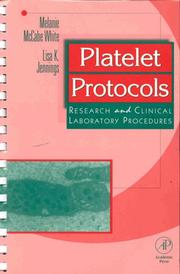
ISBN: 0123842603 9786611046620 1435605004 1281046620 0080539122 9780123842602 9781435605008 9780080539126 Year: 1999 Publisher: San Diego Academic Press
Abstract | Keywords | Export | Availability | Bookmark
 Loading...
Loading...Choose an application
- Reference Manager
- EndNote
- RefWorks (Direct export to RefWorks)
Platelets are fragments of blood cells that occur in the blood of vertebrates and are associated with blood clotting. Scientists have made great strides in recent years in understanding what stimulates platelets to form blood clots at the molecular level and in developing drugs to inhibit platelet action. Their work has a direct effect on millions of people who deal with cardiovascular disease, strokes, surgery, physical trauma, and other conditions. While references to platelet function have been included in some large texts, there has not been a basic reference manual that researchers and cl
Blood Platelets --- Blood platelet disorders --- Blood platelets --- Platelet Aggregation Inhibitors. --- physiology. --- Aggregation --- Blood platelets. --- Blood cells --- Blood --- Blood corpuscles --- Corpuscles, Blood --- Haemocytes --- Hemic cells --- Hemocytes --- Cells --- Platelets --- Thrombocytes --- Megakaryocytes --- Research. --- Corpuscles and platelets
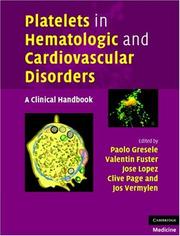
ISBN: 9780511545276 9780521881159 9780511379130 0511379137 0511378262 9780511378263 0521881153 1107184819 128124368X 9786611243685 0511377371 051137643X 0511374917 0511545274 9781107184817 6611243682 9780511377372 9780511374913 Year: 2008 Publisher: Cambridge Cambridge university press
Abstract | Keywords | Export | Availability | Bookmark
 Loading...
Loading...Choose an application
- Reference Manager
- EndNote
- RefWorks (Direct export to RefWorks)
A rapid increase in our understanding of the biology of platelets and their role in disease in recent years has been paralleled by increasing successes with established platelet-modifying therapies in many clinical conditions. This text focuses on the clinical role of platelets in a wide variety of haematologic, cardiovascular and other disorders, providing a practical, clinically relevant handbook for all clinicians and researchers interested in platelets and their role in disease. Covering platelet physiology, bleeding disorders, thrombotic disorders and antithrombotic therapy. Chapters cover all the conventional and less conventional aspects of platelet involvement in disease, with an emphasis on recent clinical developments. Clear take home messages have been included in each chapter to aid clinical practice. With contributions from leading experts across three continents, Platelets in Hematologic and Cardiovascular Disorders is an up-to-date, well illustrated, practical resource for everyone involved in clinical practice with platelet disorders.
Blood platelets --- Blood --- Cardiovascular system --- Blood Platelets --- Cardiovascular diseases --- Clinical hematology --- Hematologic diseases --- Hematology --- Platelets --- Thrombocytes --- Blood cells --- Megakaryocytes --- Diseases --- pathology --- Blood platelets. --- Diseases. --- Hematologic Diseases --- Cardiovascular Diseases --- Blood Platelet Disorders --- physiopathology
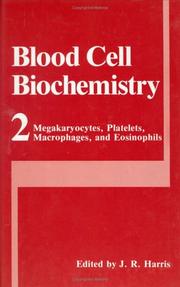
ISBN: 0306435446 1475795335 1475795319 Year: 1991 Publisher: New York, N.Y. Plenum Press
Abstract | Keywords | Export | Availability | Bookmark
 Loading...
Loading...Choose an application
- Reference Manager
- EndNote
- RefWorks (Direct export to RefWorks)
Blood physiology. Circulatory physiology --- Human biochemistry --- Blood Platelets. --- Eosinophils. --- Macrophages. --- Megakaryocytes. --- Blood platelets --- Eosinophils --- Macrophages --- Megakaryocytes --- Bone marrow cells --- Histiocytes --- Mononuclear phagocytes --- Antigen presenting cells --- Connective tissue cells --- Killer cells --- Phagocytes --- Reticulo-endothelial system --- Eosinocytes --- Eosinophiles --- Eosinophilic leucocytes --- Granulocytes --- Leucocytes --- Platelets --- Thrombocytes --- Blood cells --- Megakaryocyte --- Macrophage --- Macrophages, Monocyte-Derived --- Bone Marrow-Derived Macrophages --- Monocyte-Derived Macrophages --- Bone Marrow Derived Macrophages --- Bone Marrow-Derived Macrophage --- Macrophage, Bone Marrow-Derived --- Macrophage, Monocyte-Derived --- Macrophages, Bone Marrow-Derived --- Macrophages, Monocyte Derived --- Monocyte Derived Macrophages --- Monocyte-Derived Macrophage --- Phagocytosis --- Mononuclear Phagocyte System --- Eosinophil --- Blood Platelet --- Platelet --- Platelet, Blood --- Platelets, Blood --- Thrombocyte --- Blood Platelets
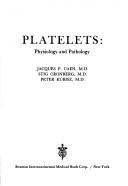
ISBN: 0913258466 Year: 1977 Publisher: New York, NY : Stratton,
Abstract | Keywords | Export | Availability | Bookmark
 Loading...
Loading...Choose an application
- Reference Manager
- EndNote
- RefWorks (Direct export to RefWorks)
Blood Platelet Disorders. --- Blood Platelets --- Thrombosis --- Thrombocytopathy --- Blood Platelet Disorder --- Disorder, Blood Platelet --- Disorders, Blood Platelet --- Platelet Disorder, Blood --- Platelet Disorders, Blood --- Thrombocytopathies --- pathology. --- physiology. --- blood. --- Blood platelet disorders --- Blood platelets --- Blood Platelet Disorders --- Platelets --- Thrombocytes --- Blood cells --- Megakaryocytes --- Blood --- pathology --- physiology --- blood --- Diseases
Book
ISBN: 1447172701 144717271X Year: 2016 Publisher: London : Springer London : Imprint: Springer,
Abstract | Keywords | Export | Availability | Bookmark
 Loading...
Loading...Choose an application
- Reference Manager
- EndNote
- RefWorks (Direct export to RefWorks)
This book provides an introductory overview of advancements in platelet-rich plasma (PRP), focusing on current technologies and methods, new challenges and controversies, and avenues for further research. With many studies demonstrating a role for PRP in improving response to injury, this book aims to facilitate the application of this rapidly growing treatment option for trauma patients. Platelet Rich Plasma in Musculoskeletal Practice is a highly informative and carefully presented book, providing scientific and clinical insight for specialists who utilize PRP in daily practice, and for readers who are seeking to learn more about this effective injury treatment. .
Medicine. --- Orthopedics. --- Sports medicine. --- Medicine & Public Health. --- Sports Medicine. --- Blood platelets. --- Blood plasma. --- Musculoskeletal system. --- Locomotor system --- Musculo-skeletal system --- Skeletomuscular system --- Blood --- Plasma (Blood) --- Platelets --- Thrombocytes --- Plasma --- Blood cells --- Megakaryocytes --- Serum --- Orthopaedics --- Orthopedia --- Surgery --- Athletic medicine --- Athletics --- Medicine and sports --- Physical education and training --- Sports --- Medicine --- Sports sciences --- Medical aspects
Book
ISBN: 9782889197408 Year: 2015 Publisher: Frontiers Media SA
Abstract | Keywords | Export | Availability | Bookmark
 Loading...
Loading...Choose an application
- Reference Manager
- EndNote
- RefWorks (Direct export to RefWorks)
Are platelets cells? (Not everyone agrees, since they are non-nucleate). And if platelets are cells - which all specialists consider at the time being - are they immune cells? The issue that platelets participate in immunity is no longer debated; however, the issue that they are key cells in immunity is challenged. It has even been proposed a couple of years ago that platelets can present antigen to T-lymphocytes by using their HLA class I molecules. No one has the same functional definition of platelets. The ‘Frontiers Research Topic’- coordinators’ own view is that platelets are primarily repairing cells, what they do in deploying tools of physiological inflammation. This function is better acknowledged as primary hemostasis, i.e. platelet adherence to injured or wounded vessels, followed by activation, aggregation, and constitution of the initial clot. Platelets would thus repair damaged vascular endothelium; so doing, as they patrol to detect damages, they sense danger along the vascular arborescence. As the latter is immense, platelets get close to tissues, which are not allowed to them under ‘physiological’ conditions but are readily accessible in pathology. Platelets are equipped with a variety of Pathogen Recognition Receptors such as TLRs; they have a complete signalosome, which is functional until the phosphorylation of NFkB; they have been proved to retro-transcribe RNA and synthesize de novo proteins; etc. Platelets participate to inflammation along the whole spectrum: from physiological (tissue repair, healing) to acute/severe inflammation (as can be seen in e.g. sepsis). In general, platelets engage complex interactions with most infectious pathogens. We propose there to cover those topics - from physiology to pathology, that put platelets within cells that not only take place in-, but also are key players of-, innate immunity. The relation of platelets with adaptive immunity is even more complex. Not everyone is convinced that platelets present antigens; however, platelets influence adaptive immunity since they have mutual interactions with Dendritic cells, Monocytes/Macrophages, and B-lymphocytes (the key players of antigen presentation); they also have mutual interactions with T-lymphocytes, though is issue is less clearly deciphered. We propose to also cover these topics - or to present the forum. There is another issue which is medically relevant - speaking of physiology/physiopathology-: this is fetal maternal incompatibility of platelet specific antigens (the HPA system) and the likely formation of maternal antibodies that often injure the newborn with risks of severe thrombocytopenia and intracranial hemorrhage. We propose an update on this issue as well. Last, platelets are very special because they can be directly therapeutic (by transfusion), even when being offered by a generous blood donor displaying given genetic and phenotypic parameters to a patient/recipient in need, who also display his/her own genetic and phenotypic parameters, which - for a large part - differ from the donor's ones. Besides immunization - via mechanisms probably close to the fetal maternal platelet incompatibility, but likely not similar -, transfusion has allowed the identification of the tremendous capacity of platelets to mediate inflammation: we propose to conclude the Topics with this item/forum.
Blood platelets --- Immunopathology. --- Immunologic diseases. --- Immunology. --- Blood platelets. --- Infection. --- Immunity. --- Immune diseases --- Immune disorders --- Immune system --- Immunologic disorders --- Immunological diseases --- Diseases --- Clinical immunology --- Pathology --- Immunology --- Infectious diseases --- Medical microbiology --- Platelets --- Thrombocytes --- Blood cells --- Megakaryocytes --- Causes and theories of causation --- Infection --- Inflammation --- immunity --- platelets

 Search
Search Feedback
Feedback About UniCat
About UniCat  Help
Help News
News